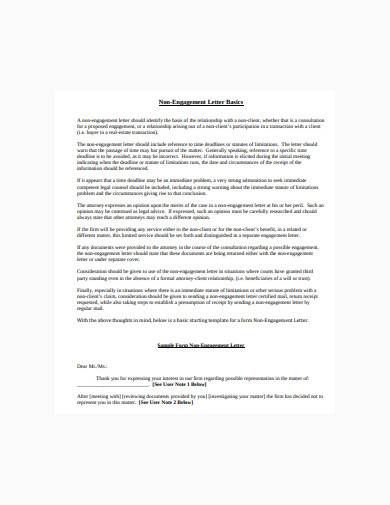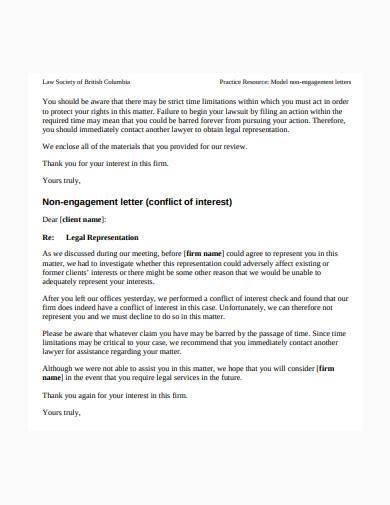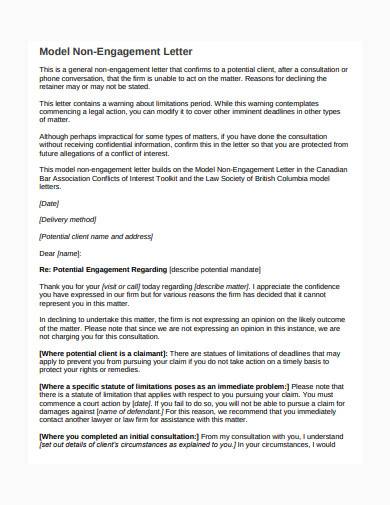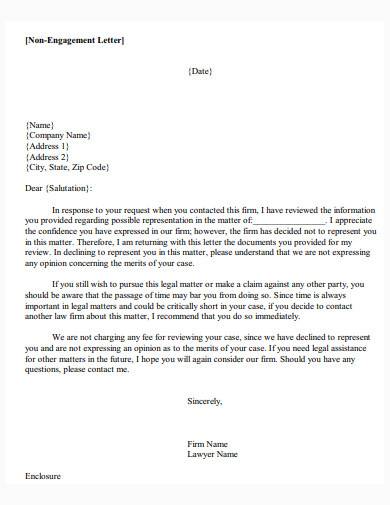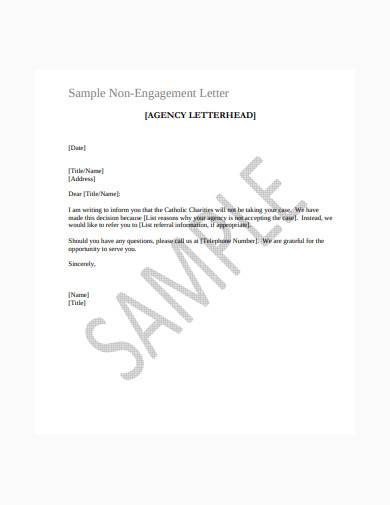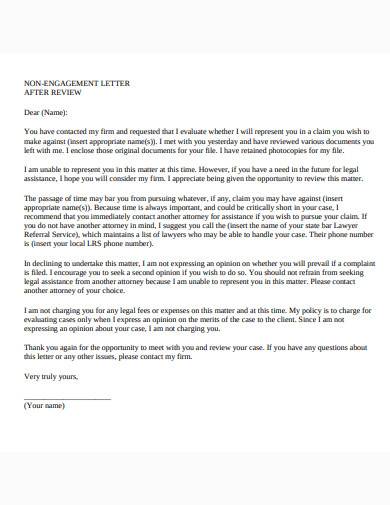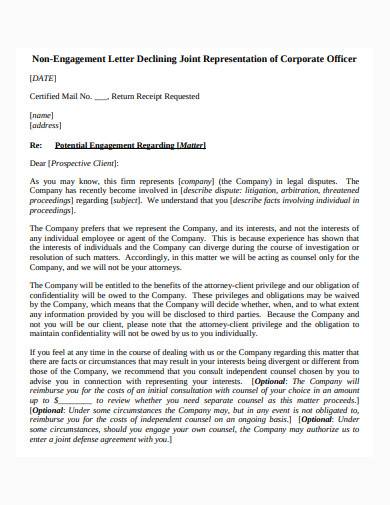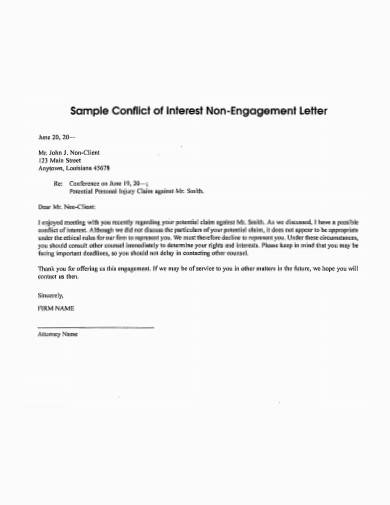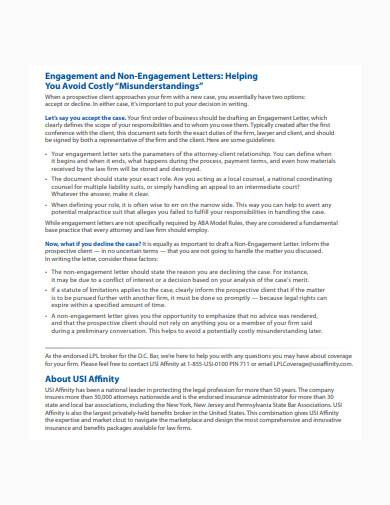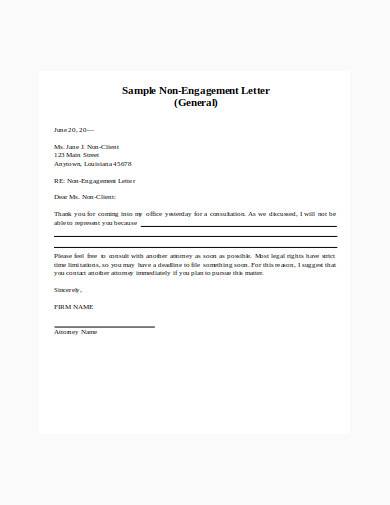One of the most dreaded questions that people have a hard time answering is the “what are we?” question when in an undefined relationship. They then get into the DTR or the “define the relationship” conversation, which is also applicable in other areas of life, such as in the law and legal realm. In what specifically? Well, in the relationship of an attorney and a client. Defining the business and legal relationship between the two is essential for various reasons. That’s why there are engagement forms and documents that attorneys use. And if an attorney rejects a client’s case, it’s best that he takes precautions and put everything in writing with the use of a non-engagement letter. What is it? Read on to know more.
The Shield of Protection for Attorneys and Lawyers
Imagine, you get into law school, graduate, get licensed, then you’re hired to work for a law firm. Months after you started working, one of your relatives sees you in a cafe, talks with you, then injected a topic about traffic laws and then proceeded to ask your legal advice. Now, what would you do? Apparently, you should know better, and politely tell him that you can’t give him any advice nor go to court with him if he requests to without getting into a legal contract with you. Why? Because he is not your client, so you shouldn’t be legally responsible for his case. And off you go!
Unfortunately, some attorneys and lawyers have been in the same situation mentioned above. Some even give their legal advice without defining their relationship with the client. But, that decision can lead to a rabbit hole of problems and lawsuits. So, what’s the best way to avoid that if you have already given your suggestions? Well, by using a non-engagement letter that states your finalized choice of not representing the client. It protects you from future lawsuits about false representation, mistreatment, fraud.
How to Write an Effective Non-Engagement Letter
Writing formal letters can be an intimidating task to accomplish since it’s essential that the recipient fully understands the concern discussed in it. So, if you’re going to write a non-engagement letter for your client, then read on to know what tips you must consider to make it an effective letter that provides enough details and protects you from future legal responsibilities as well:
1. Use polite and professional words and phrases.
No one wants to read a letter that’s full of harsh words, right? Even if it is about rejection or declination of a service requested. That’s why you must keep in mind the importance of courtesy when writing letters, especially since its about the business and legal relationship between you and the recipient. You can start by indicating a warm greeting and thanking the recipient for considering your services as one of his first options as he heads to deal with his legal disputes.
2. Specify your reasons, terms, and statements well.
Tell and be clear about your reasons why you don’t want to take the case. Apart from that, you should also include a statement about you waiving your responsibilities and liabilities towards any action that the recipient will take on behalf of what you have suggested or mentioned during the initial interview with him.
3. Suggest other firms if you have, and apologize for any inconvenience the recipient had.
Individuals involved in legal battles can come off as desperate as they need immediate help from experts. There is no time to waste, which is why if you have other firms in mind or maybe another attorney who may take up the case, you must state your suggestions in the letter. Also, a simple apologetic note will do you good as you let go of the recipient and allow him to venture on to other legal professionals for help.
9+ Non-Engagement Letter Samples in PDF | DOC
As stated, non-engagement letters protect lawyers and attorneys. But, if you’re not an expert in the area of creating or writing letters yet, then discover the different varieties of non-engagement letters that you can use as a guide below:
1. Basic Non-Engagement Letter Sample
2. Non-Engagement Letter Template
3. Model Non-Engagement Letter Sample
4. Non-Engagement Letter Sample
5. Non-Engagement Letter in PDF
6. Non-Engagement Letter Example
7. Formal Non-Engagement Letter Sample
8. General Non-Engagement Letter Template
9. Sample Non-Engagement Letter Example
10. Non-Engagement Letter in DOC
Is it necessary to add the banner or letterhead of my law firm to the non-engagement letter?
No, it is not necessary. However, adding the banner or the letterhead of your law firm allows the recipient to know that you are using and sending him a non-engagement letter authorized by your firm. Apart from that, it also entails uniformity between all legal forms and documents that you and your colleagues in the firm use.
Are disengagement letters similar to non-engagement letters?
Both disengagement and non-engagement letters are for the use of an attorney, but they are not similar. In specific, a disengagement letter is a type of formal termination letter that revokes the relationship between an attorney and a client. On the one hand, a non-engagement letter is for documenting that an attorney or a law firm has refused and declined any business and legal relationship with a recipient or a client.
Can I use letter templates instead of making one to discuss the non-engagement preference of my law firm?
Yes, you can use non-engagement letter templates instead of making one from scratch. In fact, you can easily download and edit our samples listed above with no fees and subscription requirements to fulfill.
Unintended clients, phantom clients, and whatever you call them should not become one of your burdens as an attorney, lawyer, or law practitioner. That’s why you must value non-engagement letters as they serve tons of purpose to you, your firm, as well as to the court. Don’t let complacency get into you, make and use one immediately when you face clients whom you will decline of legal services.
Related Posts
5+ Sample Self Employment Agreements
Termination Letter Format
7+ HR Agreement
7+ Music Agreement Contract Samples
8+ Sample Casual Employment Agreements
100+ Simple Letters
5+ Sample Self Employment Agreements
45+ Sample Gift Letters
6+ Sample Business Buyout Agreements
FREE 9+ Accounting Proposal Samples
FREE 3+ Sample Collective Bargaining Agreement Templates
FREE 11+ Donation Thank-You Letter Samples
Business Agreement Form
11+ Sample Partnership Proposal Letters
7+ Sample Business Agreement between Two Parties

